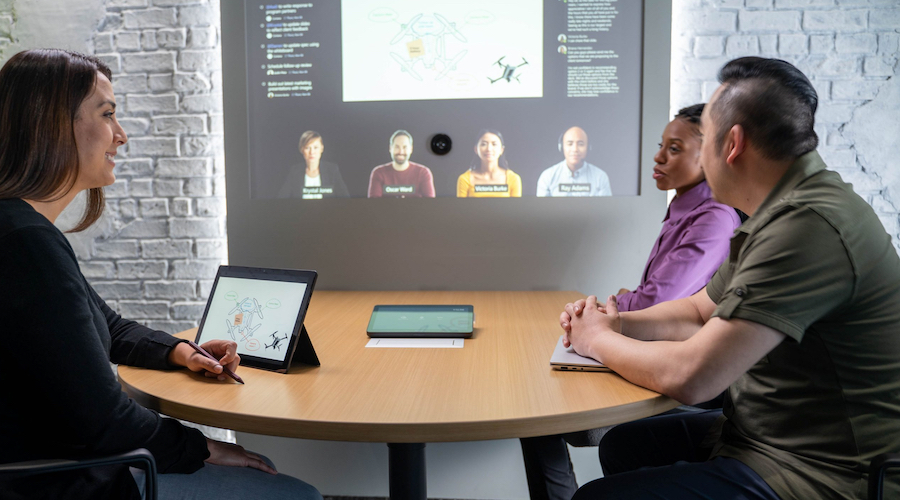
Reimagining the Meeting Room for the Hybrid Work Era
How Meeting Room Design Can Meet Workers Where They Are
As everyone knows, the pandemic of the last many years created a new work-from-home revolution as companies faced office shutdowns and work went remote. Practically overnight, most employees became proficient with Zoom, Microsoft Teams, WebEx, and cloud-based collaboration platforms for a new way of communicating, meeting, and collaborating.
But was it really a revolution? Or did the pandemic shoot a giant dose of adrenaline into the arm of a long-term trend? The truth is, remote work and workers were already a thing before anyone could spell COVID. Companies large and small had already discovered the benefits of a virtually connected organization. Using the aforementioned tools from Microsoft, Zoom, Cisco and many other companies, organizations discovered the benefits of not having a physical location – in terms of costs, employee satisfaction, hiring flexibility, and other areas. If your organization is completely virtual, perhaps you can stop reading here – you might not care about meeting rooms or hybrid work.
However, we know that most organizations still need and rely on physical worker interaction and collaboration. It may be due to the business model, product or services, supply chain, or other business factors. And many companies are struggling to define just how hybrid work will work for their organization, which leads us to the meeting room. After all, if all your staff had to do is sit in front of a computer doing their work all day long in a cubicle or open office space, you don't need them back in the office. But if they benefit from and need in-person collaboration, your current meeting room design may not work for a model where some are in the office and others are remote.
Let’s explore the issues with current meeting room design and how you can reimagine your spaces for a hybrid work model below.
SEE ALSO: 4 Considerations for Meeting Room Design in the Hybrid Workplace
Creating Equitable Meeting Experiences
Work is no longer tied to an office. It may be at home, a local shared workspace, or Starbucks. How do you tie teams together in these disparate spaces when they meet? The main unified collaboration platforms have been rapidly innovating to create more equitable meeting environments for both physical and virtual attendees. One of the thorniest issues in virtual meetings is who gets to speak. Without good eye contact and body language, people may not know when to interject. Current meeting room design tends to miss the mark for visuals. A single camera of meeting room participants may seem to remote attendees like peering through a straw (credit Microsoft for the analogy).
The solutions include new meeting room layouts and AV equipment to ensure remote attendees get a true, equitable meeting experience. Innovations like Microsoft's Front Row and Zoom’s Smart Gallery are changing how conference rooms are designed and meetings are conducted. For example, rather than having people at a traditional long rectangular or oval table where it's difficult to see people's faces and body language, these views use new cameras and processing to give remote attendees the same view that others have of them sitting right in front of their computer's camera.
Hearing is Understanding
Conference room audio is always an issue whenever any conference room attendee. For hybrid work and collaboration, nothing can be more frustrating than not hearing clearly. The person speaking that isn't being heard has little visual or other clues that remote participants can't understand what they're saying. One solution is smart microphones that recognize specific voices, execute on-the-fly speech-to-text, and even offer translation capabilities for broader audiences. Yealink’s collaboration and integration with Microsoft’s MSpeech capabilities is one such example for Microsoft Teams users. Services like Otter.ai bring similar capabilities with speech-to-text captioning for Zoom meetings.
Bringing the Meeting Room to the Worker
Not every remote worker is an individual on a computer. Increasingly, organizations find that they have clusters of remote workers in desirable remote locations. They should also have the ability to collaborate in person with teams back in the main offices. Companies will increasingly have to think about "pop-up" conference rooms that provide equitable – and productive – meeting experiences in smaller locations. This might entail a portable camera, microphone, and projector setup that can be set up in a shared workspace room or even a worker's home with enough space. This type of solution would also need to integrate with the company's collaboration platform. The advantage? Companies can hire skill sets wherever they are and want to live and provide them the tools to be productive team members.
Level 3 Audiovisual is a Tempe, Arizona-based national managed services provider helping organizations of all sizes in the Phoenix area and across the U.S. design, deploy, and manage AV systems and infrastructure. Learn more about meeting room design for hybrid work by reaching out to Level 3 Audiovisual or clicking the chat box below to connect instantly. We look forward to working with you.

